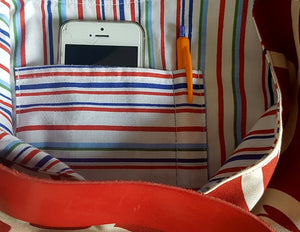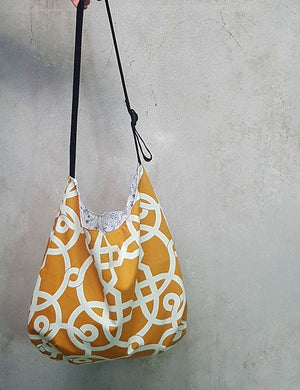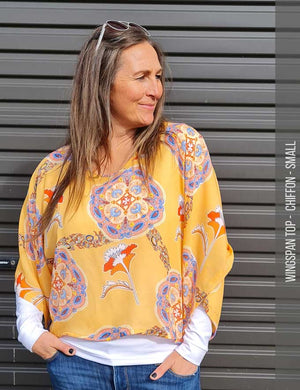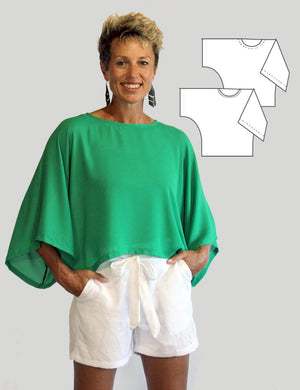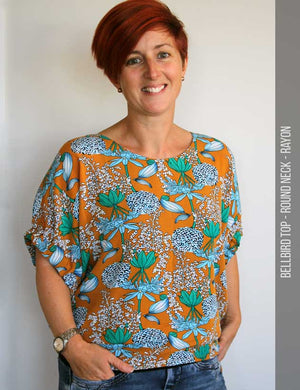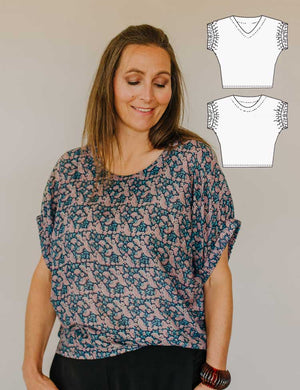A fabric is a material made through weaving, knitting, spreading, crocheting, or bonding (like gluing or felting) that may be used in production of further goods (like garments, curtains or bags). A textile is any material made of interlacing fibres, (all fabrics plus things like carpet). A subtle difference but a distinction none-the-less.
The fabrics we recommend for most of our sewing patterns are either woven or knitted.
WOVEN FABRICS
WARP & WEFT THREADSA woven fabric is created by weaving horizontal (latitudinal) threads under and over vertical (longitudinal or lengthwise) threads. The threads running horizontal are called WEFT threads and those running vertical are called WARP threads.

The lengthwise or longitudinal warp yarns are held stationary in tension on a frame or loom while the transverse weft (sometimes woof) is drawn through and inserted over-and-under the warp. A single thread of the weft crossing the warp is called a pick. Terms vary (for instance, in North America, the weft is sometimes referred to as the fill or the filling yarn). Each individual warp thread in a fabric is called a warp end or end. The weft threads wrap the end warp thread to weave back again in the other direction. The end turning point creates the selvage - the edge that runs the length of the fabric.
When you lay out a pattern you need to ensure the grain lines run parallel to the warp thread.
FABRIC ON THE BIASFabric that is "cut on the bias" is cut on a 45 degree angle to the warp and weft threads.This allows the weave to "move" and drape better. Some garments are cut on the bias allowing the woven fabric to follow the shape of the body more closely. How well a fabric "drapes" also depends upon the thickness of the warp and weft threads and how tightly these are woven together.
Bias tape (or bias binding) is a strip of bias fabric with the long raw edges folded toward the center of the strip. Bias tape is great for attaching to the finished edge of a curve in your garment (like an armhole or curved neckline).

Learn how to make your own bias tape here.
KNITTED FABRICS
A knitted fabric is one that has been created by "knitting" the fibres or strands together. The most basic of knits is when the fibre is wound around a knitting needle in a "over and around, down and around" movement (knit one, pearl one). Many more variations of knitting stitches create different "patterns" on the fabric - but the ones we most use in our garments are plain knits.
Knit fabrics "move" much more than woven fabrics (in some cases they stretch significantly) depending on the "knitting stitch" or method used to put them together. So they can be used for different things.

A cotton jersey knit (like T-Shirts), uses fine cotton plain knit to create a soft fabric that moves a little when you wear it. Light weight jersey knits can also be created by knitting together synthetic or man made fibres like polyester.
Fine natural wool knits (created from knitting together fine wool fibres like merino sheep wool and angora goat wool) are from animal breeds especially bred to produce very thin fibres. Merino fibres can be woven into fabrics too (often used in up market suiting), but they are more commonly knitted. Fine merino can be knitted into socks and undergarments (the backbone of the NZ outdoor clothing brand Icebreaker). Fine knit fabrics (cotton T shirting and fine merino knits) are knitted by machines and the knitting needles are so small, to do so by hand would be difficult and arduous.
HEAVY KNIT FABRICSThese are simply created by using thicker (heavier) fibres - using coarser sheep wool for example, or wool that is spun into thicker strands (called yarn). Using larger fibres (lake yarn we can buy in the craft store), allows us to knit on traditional knitting needles by hand. Heavier and/or thicker synthetic or man made fibres can also be knitted to create heavier fabrics.
A VARIETY OF KNITTING STITCHES
Different knitting stitches are used to create different visual patterns for aesthetic purposes and others for functional purposes. A ribbing stitch, for example, if often used around neck, arm and hem bands of a garment to allow the bands to stretch enough so the wearer can put them on, and then rebound back against the skin.
STRETCH FABRIC
Whilst a knitted fabric "moves" (think about how a knitted woollen jersey or a T-shirt (knitted cotton) will stretch over your head with a ribbing stitch but a woven garment will not), eventually the knitted garment will loose it's ability to rebound back in to shape. The ability to rebound is referred to as the fabric's "memory".
Spandex or elastane is a synthetic fiber (made from petroleum), is known for its exceptional elasticity. The product was invented in 1958 by chemist Joseph Shivers at DuPont's Benger Laboratory in, Virginia, USA. The name "spandex" is an anagram of the word "expands". "Lycra" is actually a brand of elastane rather than a product itself.
When an artificial fibre, like elastane, is woven into or knitted into a fabric, the fabric's stretch and ability to rebound is significantly enhanced. The more elastane, the more stretch (like pantyhose). This significant invention now allows even woven fabric to stretch (and rebound), a function previously limited to particular knitted stitches (like ribbing).
Whilst stretch fabrics are extremely useful in some areas and have overtaken traditional knits in some areas of construction, there is a conscious move back towards traditional knitting by some garment manufacturers conscious of the negative environmental impact of synthetic fibres that do not break down in landfill.
See our video on HOW TO MEASURE FABRIC STRETCH here.
Some common examples of stretch fabrics include:
BENGALINE- a woven stretch - The versatility of bengaline comes from it's crosswise rib that gives a lengthwise stretch. Often made from a combination of rayon, nylon, viscose, wool, spandex and cotton. Perfect for our Pukeko Pants.
PONTE (PONTI) - a knit two way stretch - A thick, double-knit fabric with two-way stretch. Two way stretch is important because it moulds to your body-shape and holds you in at the same time. Perfect for our Pukeko Pants.
COTTON ELASTANE - a knit two way stretch - made from a combination of cotton and elastane (lycra is a brand of elastane) -usually 95% cotton and 5% lycra/elastane. The cotton allows the fabric to breath naturally and the lycra/elastane helps the fabric retain it's "memory" - the ability to stretch and retract without loosing original shape. This fabric is great for cuffs, neck, wrist and hem bands in can be used in place of ribbing.
We use cotton/elastane fabric as neck,wrist and sometimes hembands in our Skullduggery dress & tee, Rosella top and popular Kingfisher Top.
MEASURING FABRIC STRENGTH & DENSITY
Fabric weight, strength and drape depends on a number of things:
- the thickness of the fibres used to create it;
- the closeness (density) the fibres are knitted or woven together;
- the strength of the individual fibres themselves (spider silk is the strongest natural fibre known).
Finer fibres generally create a lighter fabric (fine silk and merino wool) and is measured in "denier" or "microns". Fabrics with a high denier count tend to be thick, sturdy, and durable. Fabrics with a low denier count tend to be sheer, soft, and silky.
Density is measured as "thread count" (which is how many threads or fibres per square inch (2.5 sq cms). Thread count (often displayed on the label when buying bed sheets) - the higher the thread count the higher the quality of the bed sheet. More fine threads that are woven tightly can fit into an inch than coarse large threads.
FABRIC DRAPE
The drape of the fabric is how well a fabric "drapes" or falls over an object (or human body). A soft drape (or well draped fabric) falls softly downwards and hugs the form of the object. A coarsely draped fabric keeps more of it's original structure when placed over an object.
Softly draping fabrics (fabrics with lots of drape) are constructed with fine, flexible fibres using looser (less dense) weaves and knits. Examples are chiffon (see-through fabrics), light weight cotton jersey (T shirting), fine silks and light weight wools.
Course draping fabrics (or fabrics with little drape) are often tightly woven fabrics made of stiff thick fibers (like canvas and plastic sheeting).
You can increase the drape of a woven fabric significantly by hanging it on the "bias" (and thereby loosening the weave).
The drape is sometimes also referred to as the "handle". A fabric may feel "soft" or "hard" to handle (ie, how it feels in your hand).

